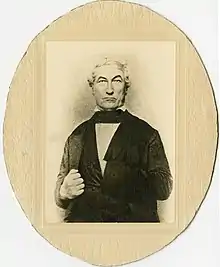Allan Morrison (fur trader)
Allan Morrison (June 3, 1803 – November 21, 1877), alternatively spelled Allen Morrison, was a Canadian-American fur trader and politician who served in the House of Representatives during the first session of the Minnesota Territorial Legislature.
Allan Morrison | |
|---|---|
 Morrison, circa 1865 | |
| Member of the Minnesota Territorial Legislature House of Representatives | |
| In office September 14, 1849 – December 31, 1850 | |
| Preceded by | William Sturgis |
| Personal details | |
| Born | June 3, 1803 Montreal, Quebec |
| Died | November 21, 1877 (aged 74) Present-day White Earth Indian Reservation, Minnesota |
| Political party | Democratic |
| Spouse | Charlotte Charbouillier |
| Relations | William Morrison (brother) |
| Occupation | Fur trader |
He is the namesake of Morrison County, Minnesota, along with his brother William.
Biography
Morrison was born in Montreal[1] to Allan Morrison, Sr. and Jane Wadin. Wadin's father was Jean-Étienne Waddens, a fur trader who was killed by Peter Pond in 1782.[2]
Morrison came to northern Minnesota for the fur trade c. 1820 and was associated with William.[1] He successively ran posts at Big Sandy Lake, Leech Lake, Red Lake, Mille Lacs Lake, and Old Crow Wing.[3] He stayed at Old Crow Wing until 1874 and is considered the first white person to settle there.[1] Upon the establishment of Crow Wing County in 1857, Morrison was listed as one of its county commissioners.[4]
Morrison was elected to the Territorial House of Representatives in 1849, following the resignation of William Sturgis. He was a representative until the session ended at the start of 1851.[3]
Morrison, with his brother William, became the namesake of Morrison County when it was founded in 1856. This was in large part due to the fact that Allan forwarded a letter to Alexander Ramsey detailing William's exploration of Lake Itasca. Ramsey circulated the letter and gave it large publicity, perhaps influencing the legislature to name the county after the brothers.[1][2]
In 1874, Morrison accompanied Chippewas as they were relocated to the White Earth Indian Reservation. He died there on November 21, 1877, and was buried there.[3]
Morrison married Charlotte Charbouillier, a part Chippewa. With her, Morrison fathered eleven children.[3]
References
- Upham, Warren (1920). Minnesota Geographic Names. Minnesota Historical Society. p. 350. Retrieved February 5, 2021 – via Internet Archive.
- Mellor, Bruce (14 July 2009). "William Morrison – Fur Trader". Morrison County Historical Society. Retrieved February 5, 2021.
- Hubbard, L.F.; Murray, W.P.; Baker, J.H.; Upham, Warren (1908). Minnesota in Three Centuries, 1655-1908: Early history. Publishing Society of Minnesota. Retrieved February 7, 2021.
- Minnesota and Its People. S. J. Clarke Publishing Company. 1924. Retrieved February 8, 2021.